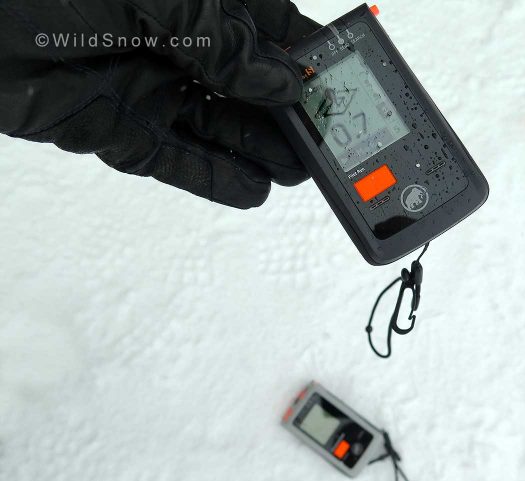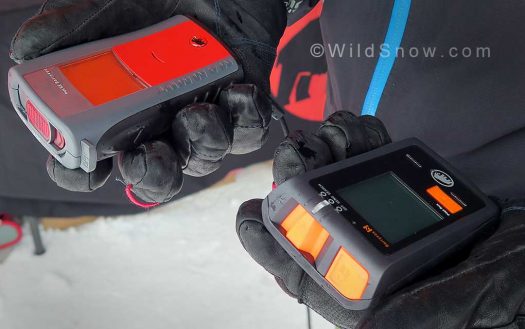Okay kids, avalanche beacon theories of evolution. Operative word: “urgency.”
As one of the few, the proud, the brave who actually ski toured before widespread acceptance of electronic avalanche rescue beacons, I’ve got an overall sense of how things have progressed. My recollection is that early theory of avalanche rescue assumed buried victims had a longer grace period before suffocation than what we now know to be true.
For example, it was assumed you could tie into a brightly colored string known as an “avalanche cord,” which was then followed to your burial location as you lay there dreaming about your next Florida beach vacation. Presumably this was done by pulling the string up out of the snow, eventually tugging on the victim and interrupting their reverie.
As you can imagine, theory was not practice. The string could get wedged under snow blocks, and was 100% likely to get broken or tangled if any vegetation was present. Not to mention the challenge of skiing with a string whipping around your legs. I’d imagine the avalanche cord might have saved a life or two over the years, but not to any measurable extent of improving avalanche safety for the overall ski touring public.
Another example: It was not uncommon in the early days, when beacon use became more accepted, for skiers to not carry a shovel or a probe. The assumption was you’d just dig that Florida dreamer out with your hands and a ski. It took a few preventable tragedies to put a stop to this.
Thus, through past decades, specious theories of avalanche rescue have made way for real world vetted methods. Biggest events in that vein: Invention of the actual electronic locator, then, the digital multiple-antenna beacon. Both were quantum leaps. But one part of the equation still remains a challenge, though we continue to hone in on the solution. That being the fine search.
If a victim is buried near the surface, you can often walk your digital beacon into their location within the distance of a shovel blade or better. Increase burial depth, and you may reach a wall of confusion that despite all sorts of “fine searching” is ultimately solved using a spiral pattern with your avalanche probe. The fine search is time consuming and confusing for many people, often involving use of an archaic “grid” pattern method that isn’t much different than what we were doing 35 years ago. Only back then we had beacons with audio signals I remain convinced were easier to utilize than flashing lights and tiny confusing LED icons.
Yes, still room for improvement. Still room for beacons that make the search process as seamless as possible. Still room to better utilized hearing instead of eyesight.
Yesterday here in Utah, at Outdoor Retailer, we got to check out a couple of new beacon offerings from Mammut that clearly do continue the positive trends mentioned above. Efforts are being made to speed up that annoying and downright dangerous final fine search, and audio signals are not an afterthought.
Indeed, we were shown that “high fidelity” sound is part of most search procedures. Most useful is perhaps that of having two different beep tones when you’re tracking two buried beacons. Of course, noise is part of how other brand beacons operate, some with it more useful than others. In the case of these new Baryvox units, sound is most certainly not a cute racket pretending to be something useful, but rather carefully designed audio intended to be an integral part of how your brain receives information from the beacon.
Audible search beeps are available with both beacons. Mammut calls this “acoustic search guidance.”
The new beacons are the Barryvox and Barryvox S. Mammut kept the basic functions of both the Element and Pulse beacons (respectively), with goals to improve the simplicity, ease of use and the performance of both beacons. On first glance, it appears they did a good job approaching those goals. Following is a combo of what we observed in a quick session, and what we were told by the marketeers. Our comments in parenthesis.
Barryvox S: Designed for single burials, or extremely difficult multiple burials involving signal overlap. Compared to its predecessor the Pulse, the Barryvox S has higher performance overall, a simpler user interface, and new background programming that makes searching easier and faster.

Barryvox2 offers various features to pinpoint probe spot. In our opinion, speeding up the fine search is about a thousand times more important than your multiple burial features. Kudos to Mammut for addressing this, though we suspect there may be a time in the closer future when avalanche beacons work so well they eliminate the need for a probe. I know a few active backcountry skiers who feel this might already be the case, and have verified during practice sessions (with use of a single ski pole sans basket for quick probing after a properly done fine-seaerch). In our opinion jury is still out on that, but it’s food for thought. Dogma has no place in all this, everything is evolving at a rapid pace.
Barryvox: a more basic beacon that will appeal to those who place the highest priority on simplicity and value. Again, this is the replacement for the Element model.
Both new beacons feature:
Available October 2017.
WildSnow.com publisher emeritus and founder Lou (Louis Dawson) has a 50+ years career in climbing, backcountry skiing and ski mountaineering. He was the first person in history to ski down all 54 Colorado 14,000-foot peaks, has authored numerous books about about backcountry skiing, and has skied from the summit of Denali in Alaska, North America’s highest mountain.


